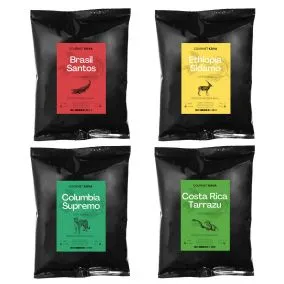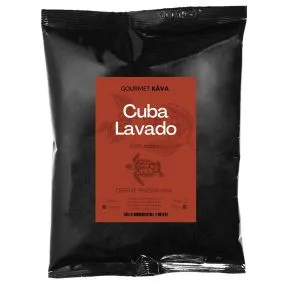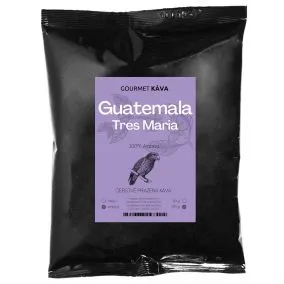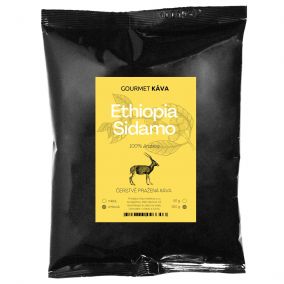The coffee tree is part of the botanical class Rubiace and the order Coffea. Of the many species of coffea, two main species are usually used for coffee production: Arabica and Robusta. Arabika is milder and has less caffeine than Robusta. Arabica was imported by the Arabs in the 15th century from East Africa to Arabia. Robusta is stronger and has more caffeine, making it more stimulating. Arabica grows in higher, cooler regions, while Robusta prefers tropical, flatter areas.
The coffee tree can reach heights of 3 to 13 metres, but is usually kept at 1.5 to 3 metres in plantations for easier harvesting. It takes eight months for the coffee bean to develop into a plantable plant and another two to six years before the first harvest can be made. Coffee trees flower once a year and give off a jasmine-like fragrance. Ripe coffee berries can be on the coffee plant at the same time as the flowers. One adult coffee tree can produce 5 to 8 kilograms of coffee fruit, which can yield 1 to 2 kilograms of coffee beans.
Coffee trees need a tropical climate to grow and are sensitive to extreme temperatures, whether low or high.
Coffee trees have specific soil and climate requirements. The ideal soil for coffee trees is deep, rich in organic matter and well drained. Coffee trees also need regular rainfall, but it is important that they are not subjected to too long periods of drought.
Coffee harvesting
When coffee berries reach their ripe red hue, it's time to harvest. Harvesting is usually done by hand, with workers carefully selecting only the ripe fruit. After harvesting, the coffee beans are processed using various methods to remove the outer skin and flesh, leaving only clean coffee beans.
Coffee processing
The processing of coffee beans is a crucial step that can greatly affect the taste of the finished coffee. There are different processing methods. Each method has its own advantages and disadvantages and can impart unique characteristics to the coffee.
After processing, the coffee beans are dried in the sun or in drying machines until they reach the optimum moisture content. The beans are then stored before being sent for roasting. Roasting is another critical step in the coffee production process, where the beans are heated to high temperatures, leading to chemical reactions that shape the coffee's characteristic flavour and aroma.
In the Czech Republic, coffee is a very popular drink and many people enjoy it every day. Whether you prefer a strong espresso, a latte macchiato or a classic black coffee, it is important to remember how much work and care goes into growing and processing the coffee beans that end up in our cups.
Growing coffee around the world
Coffee is grown in many countries around the world, especially in the Americas, Africa and Asia. There are countries with small but unique production, and then there are countries that produce huge amounts of green coffee.
The last two decades have seen several changes in the ranking of the world's largest coffee producers. Here is a list of the top 10 coffee bean producers in the world as of 2014:
- Brazil - 2,720,520,000 kg
- Vietnam - 1,650,000,000 kg
- Colombia - 750,000,000 kg
- Indonesia - 540,000,000 kg
- Ethiopia - 397,500,000 kg
- India - 344.760.000 kg
- Honduras - 279,000,000 kg
- Mexico - 240,000,000 kg
- Uganda - 240,000,000 kg
- Guatemala - 210,000,000 kg
In addition to these major producers, quality coffee is grown in other countries such as Costa Rica, Panama, Peru, Ecuador, Cuba, Zimbabwe, Tanzania, Kenya, Malawi, Thailand, Laos, Myanmar, Nepal and China.
Lavado coffee from the mountains of south-eastern Cuba will surprise you almost zero acidity and a distinctive taste of dark chocolate and caramel.
Lavado coffee from the mountains of south-eastern Cuba will surprise you almost zero acidity and a distinctive taste of dark chocolate and caramel.
Guatemalan Trés Maria coffee stands out for its perfect balance and pleasant sweetness complemented by the taste of ripe tropical fruits.
Guatemalan Trés Maria coffee stands out for its perfect balance and pleasant sweetness complemented by the taste of ripe tropical fruits.
Exceptionally low acidity and chocolate flavour come together in Brazil Fazenda Rainforest coffee, which you can buy to support the idea of an ecological and socially friendly way of growing coffee.
Exceptionally low acidity and chocolate flavour come together in Brazil Fazenda Rainforest coffee, which you can buy to support the idea of an ecological and socially friendly way of growing coffee.
Ethiopia gave its name to coffee after the Ethiopian province of Kaffa, so it's no surprise that some of the best coffee in the world is grown there.
Ethiopia gave its name to coffee after the Ethiopian province of Kaffa, so it's no surprise that some of the best coffee in the world is grown there.
A unique blend of 5 varieties of Arabicas from Central and South America , complemented by a quality robusta for an espresso full of flavour, strength and quality creams.
A unique blend of 5 varieties of Arabicas from Central and South America , complemented by a quality robusta for an espresso full of flavour, strength and quality creams.
Cuba Lavado, arabica coffee beans
Guatemala Trés Maria, arabica coffee beans
Brazil Fazenda Rainforest, Arabica coffee beans
Ethiopia Sidamo, Arabica coffee beans
Espresso blend Pura Vida, coffee beans



































































































